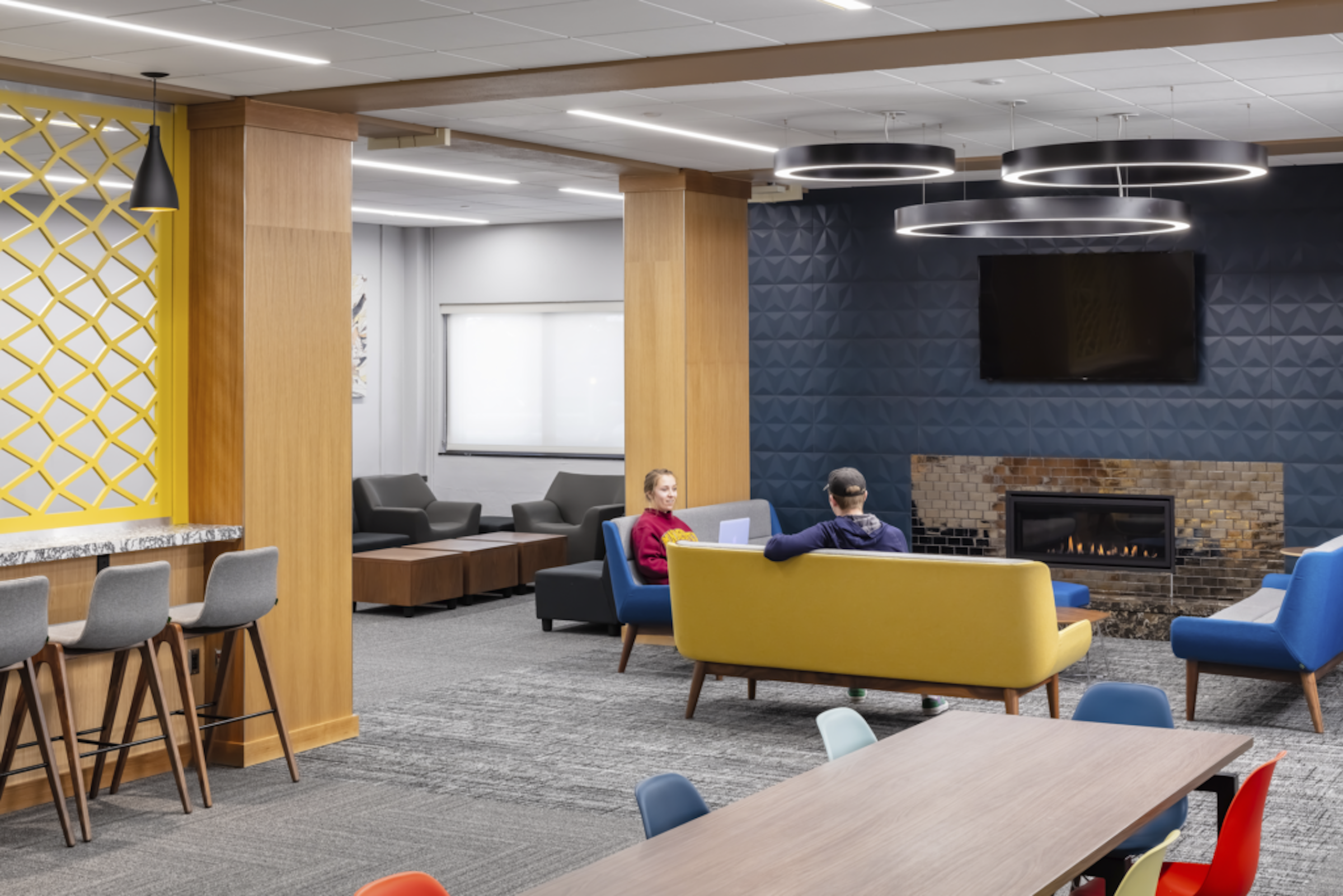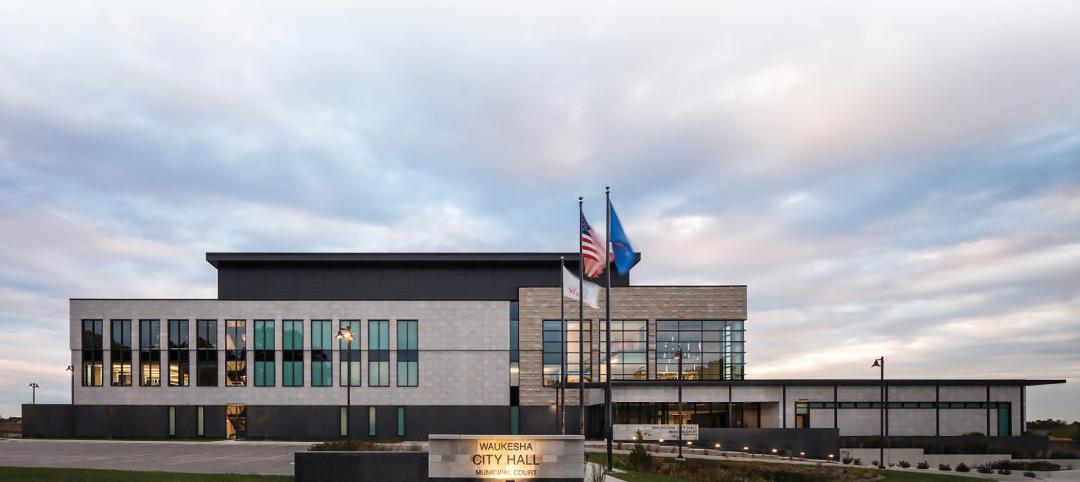Student housing is commonly associated with bare-bones accommodations designed to be tolerated rather than enjoyed. However, today’s residence halls are advancing in remarkable ways to better foster community, support student well-being, and reflect each institution’s unique culture.
The days of uninspired dorm rooms with little more than a bed and a communal bathroom down the hall are long gone. Students increasingly seek inclusive design, communities to enhance learning and living, and a focus on wellness that encompasses everything from meditation spaces to mental health resources.
In the latest episode of Side of Design, BWBR team members Amanda Aspenson and Anna Pratt, both Senior Project Managers, and Senior Architectural Designer Kevin Gamelin discuss the evolving world of student housing design.
BUILDING COMMUNITY
Beyond simply providing a place to sleep and study, today’s student housing seeks to foster community and encourage interaction among residents. Strategically placed community spaces, amenities that bring students together, and open layouts are just a few ways our designers can help make the difference between one-time encounters and budding connections between students.
Kevin explains that finding new ways design can set relationships in motion is a major driver for universities today – and there isn’t just one concrete solution. “How do we make these spaces become a community and really drive what brings people together? How can we encourage students to interact beyond the traditional dorm room in the corridor? How can we open it up and make spaces that are private but public and semi-public to build these interactions?” he asks.
BWBR’s designers are consistently innovating, problem-solving, and finding creative answers to these questions to meet the unique needs of institutions. Some universities are transforming student housing with pod-style layouts with clusters of suites centered around a common area, allowing strong bonds to form within smaller groups. Others are opting for townhome-style units that offer a mix of private and shared amenities. Both traditional dormitories and new approaches to campus living offer distinct opportunities to explore community-building through strategic design.
THE POWER OF FLEXIBLE DESIGN
A focus on holistic design demands an acknowledgment that individual needs are different, and so are the needs of different campuses. These needs aren’t static, either. They change from year to year and decade to decade – so designers can’t only consider the current student population.
That’s why our team emphasizes the significance of flexibility in student housing design. Anna says this came into play at Fraternity and Sorority Life Housing at the University of Nebraska at Kearney, where the designers accommodated varying chapter sizes and the potential for growth or contraction over time. “We were strategic in how those buildings were laid out, different locking mechanisms on the doors, and where doors were placed within corridors so fraternities and sororities can grow and expand or shrink as the years go by,” she explains.
Enrollment numbers are likely to fluctuate, and as Kevin and Amanda point out, flexibility can also mean enacting universal design as much as possible to accommodate accessibility needs or designing infrastructure that easily accommodates future renovations. Even giving students the power to control elements like temperature and lighting to their preferences makes a big difference in comfort.
WHAT’S THE FUTURE OF STUDENT HOUSING?
Of course, we can’t talk about the evolution of student housing without discussing what lies ahead. So, what is next for the future of student housing?
The answer lies at least in part with the students themselves. “Students are so savvy in terms of bigger, broader issues, with sustainability and accessibility only being two of those,” Amanda says. “We’ve had students come to user group meetings asking, ‘What recycled content do you have in your materials? Are all of your materials low VOC or bio-based materials?’ Students are asking these really smart questions.”
As universities continue to compete for top student candidates, student housing design will undoubtedly play an increasingly important role in recruitment and retention efforts. By creating spaces that foster community, support well-being, and reflect the values of those who will spend time there, the BWBR team is helping to shape the future of higher education – going beyond the basics of student housing design.
More from Author
BWBR | Oct 9, 2024
How healthcare operations inform design
Amanda Fisher, Communications Specialist, shares how BWBR's personalized approach and specialized experience can make a meaningful impact to healthcare facilities.
BWBR | Sep 9, 2024
Exploring the cutting edge of neuroscience facility design
BWBR Communications Specialist Amanda Fisher shares the unique considerations and challenges of designing neuroscience facilities.
BWBR | May 23, 2024
The unique design needs of Critical Access Hospitals
BWBR healthcare principals Brad Krump, AIA, and Scott Kirchner, AIA, discuss their industry experience and passion for supporting the role that critical access hospitals play in their communities.
BWBR | Mar 8, 2024
Conference room design for the hybrid era
Sam Griesgraber, Senior Interior Designer, BWBR, shares considerations for conference room design in the era of hybrid work.
BWBR | Jan 30, 2024
The practical magic of the design process
Designers bridge very different worlds, and there can be an air of mystery about the process and the various roles within it. We invited some of the BWBR team to clear things up.
BWBR | Aug 10, 2023
The present and future of crisis mental health design
BWBR principal Melanie Baumhover sat down with the firm’s behavioral and mental health designers to talk about how intentional design can play a role in combatting the crisis.
BWBR | May 24, 2023
The future of work: What to expect in 2023
While no one disagrees that the workplace has undergone tectonic changes, it is less clear how to understand these shifts and synthesize them into practical action for the coming year.
BWBR | Apr 13, 2023
Urgent care facilities: Intentional design for mental and behavioral healthcare
The emergency department (ED) is the de-facto front door for behavior health crises, and yet these departments are understaffed, overwhelmed, and ill-equipped to navigate the layered complexities of highly demanding physical and behavioral health needs.
BWBR | Apr 6, 2023
Design for belonging: An introduction to inclusive design
The foundation of modern, formalized inclusive design can be traced back to the Americans with Disabilities Act (ADA) in 1990. The movement has developed beyond the simple rules outlined by ADA regulations resulting in features like mothers’ rooms, prayer rooms, and inclusive restrooms.
















